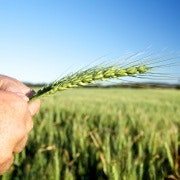How Chinese farmers can reap more than they sow
Consumer-driven organic farming practices in China have the potential to stem falling participation rates in the agriculture sector and help ensure the safety and sustainability of Chinese food production, a key Australia-China bilateral initiative has heard.
Dr Shi Yan of Shared Harvest Farm (Shared Harvest) and Manuela Zoninsein of Smart Agriculture Analytics (SAA) led a session on China's food security challenges at the fifth annual Australia-China Youth Dialogue in Beijing last month.
The current statistics on China's agriculture industry are alarming. China has only 7 per cent of the world's arable land to feed 20 per cent of the world's population; one-fifth of agricultural land is too polluted to safely grow food; the average farmer is nearly 60 years old and operates a plot of land averaging 0.5 hectares; and another 200 million farmers are expected to leave rural areas for the city over the next decade.
In light of these challenges, how can China ensure the safety and sustainability of its food production into the future?
One development in recent years has been the emergence of community-supported agriculture projects. Unlike their counterparts in Australia, Chinese farmers take on all environmental and market risks without a safety net, putting severe pressure on farmers during lean years.
CSA, a model adopted by Shared Harvest, brings together consumers and farmers so that they share the risk of food production food.
Under Shared Harvest's program, consumers contribute capital up front to pre-purchase vegetables to be organically grown by local farmers. Due to the extensive use of pesticides in China over the past decades, the land used to grow the vegetables may not meet ‘organic' marketing certification standards, but the produce is grown using organic methods without artificial pesticides or fertilisers, allowing the land to be certified organic once it has been chemical-free for three years.
At regular intervals, boxes of organically grown produce grown by the farmers are delivered to the capital-investing consumers, with the volume and mix of vegetables reflecting the seasonal production at the source farm.
There are clear benefits of the CSA model.
Consumers are able to access fresh vegetables from a source they can trust. Consumers are encouraged to visit the farm where their vegetables are grown, and know that their purchase will help the environment and provide meaningful employment for local farmers. These factors are particularly important to Chinese consumers today as they are increasingly concerned about food safety and the environmental impact of agriculture.
For the farmers, they are able to share the risk of production with consumers and effectively command higher prices for their produce, providing a level of job security that was previously impossible.
Shared Harvest's program has seen the average incomes of participating farmers double over the last two years. Farmers also have access to organic training programs run by Shared Harvest and further benefit in future years once their land is certified organic and their produce can command an even higher premium.
But CSAs will not be enough to solve all of China's food security challenges.
Despite ongoing consolidation in the agriculture sector, partially driven by continued rural-to-urban migration, Chinese agriculture is still expected to continue to be dominated by small farmers, with the average farming block expected to increase from only 0.5 hectares to seven hectares over the coming years.
By way of comparison, in 2012 the average Australian farm was 3,000 hectares in size. There is therefore a major difference in the types of technology that can (and should) be utilised by Chinese farmers to help increase their production yields.
With this in mind, companies such as SAA hope to play an important role as the technology R&D outsourcer of choice for small farmers in China, says Zoninsein.
Through its use of market intelligence on agriculture technologies across the globe, SAA aims to match small farmers with technology suited to their circumstances. SAA is working with county-level officials in various provinces across China to identify ways to help mechanise agriculture production and increase yields, through using technology such as hand-held GPSs, solar powered greenhouses, and drones which identify differences in leaf colour from the sky.
A key challenge in China will be finding a funding solution to drive the use of technology by small farmers who, by and large, will be unable to afford the technology on their own. SAA is investigating ways to bridge the funding gap, including through shared ownership models.
Zoninsein believes that China has the potential to become a world leader in the production of agriculture machinery and technology, and it may well be the case that locally made (and cheaper) products will also help drive uptake.
It will not be possible to eliminate China's food security challenges overnight, but with entities such as Shared Harvest and SAA working with Chinese farmers to help produce healthier foods and increase yields, while at the same time providing further incentives for farmers to stay on the land, the seeds for a revival in Chinese agriculture have been sown.
Aidan Lavin is a senior associate at Corrs Chambers Westgarth Lawyers in Brisbane. He was a delegate at the 2014 Australia-China Youth Dialogue.













